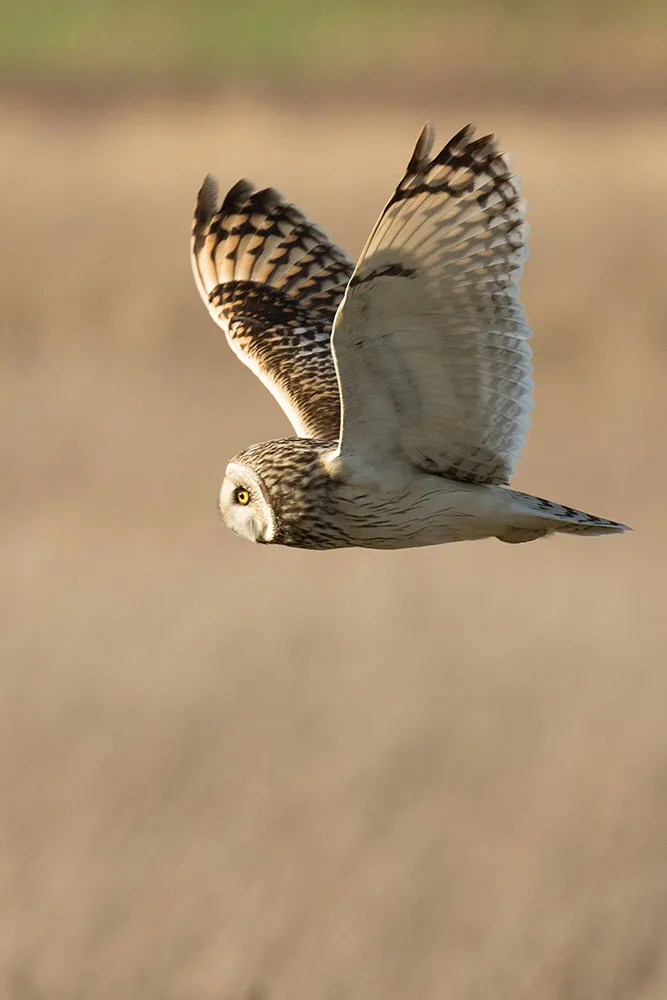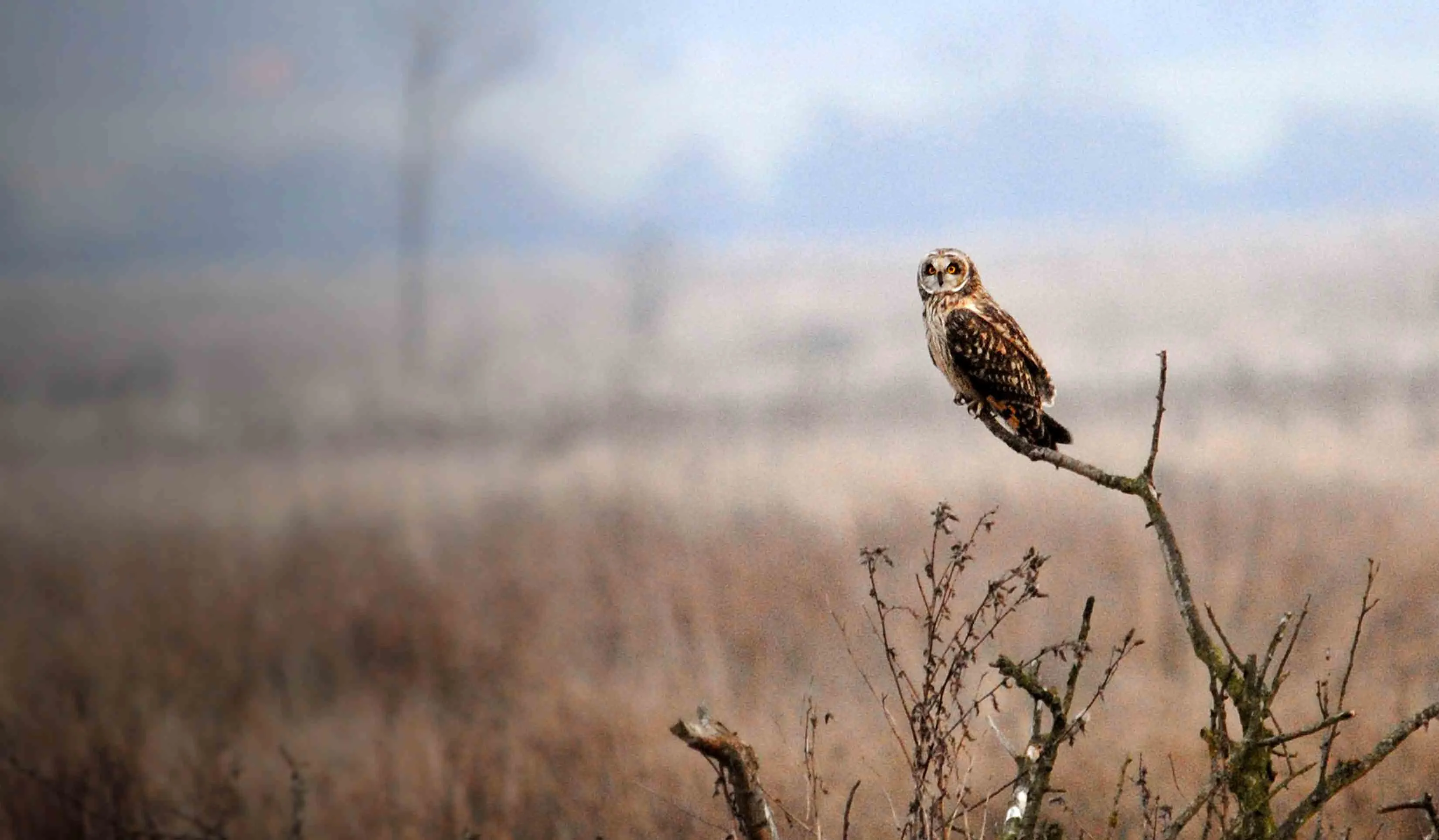Introducing Short-eared Owls
Scientific name: Asio flammeus
- Breeds in a range of open habitats including tundra, steppe, bogs, dunes, moorland, heathland, young plantations and occasionally in crops.
- Nomadic; population peaks coincide with high vole densities.
- Approximately 610-2140 pairs in the UK.
- Amber-listed Bird of Conservation Concern.
In the UK, moorlands, rough grasslands and young plantations support most of the breeding population of Short-eared Owls. During the summer months, these owls can be seen hunting during daylight hours, though most foraging occurs during the hours of darkness. In winter, they can be more widespread, but their numbers fluctuate markedly in all seasons.

Calls and identification
Short-eared Owls utilise a number of different display postures and can rely more on these than on vocalisations, reflecting their association with open rather than wooded habitats.
The male has a song consisting of ten or more hoots, sometimes delivered as part of an elaborate display flight which can last for up to an hour. The display also includes bursts of rapid wing-clapping. Other calls include hoarse screeches and barks.
Listen to a male call
Listen to call and wing clapping
This is a medium-sized owl, slightly smaller and slimmer in appearance than a Tawny Owl. The main confusion species is the Long-eared Owl and BTO has produced a useful video on how to identify the two species.
Short-eared Owls rarely display their ‘ear’ tufts, though be aware that the tufts of Long-eared Owls are not always visible. Eye colour can be useful: Short-eared Owl eyes a piercing yellow, while in Long-eared Owl they are orange. In Short-eared Owls, the eyes are framed by sooty dark feathers. They have a pale trailing edge to the wing, visible in flight, and a distinct contrast between the dark head and pale belly.
Ecology and conservation
The Short-eared Owl is a ground-nesting species, in Britain favouring mixed rough grasslands and moors, though also breeding in young plantations (usually first-generation plantings), lowland rough grassland, marshes and coastal sand dunes. They can have a protracted breeding season with some pairs settling on a breeding territory by late March and other not until May. This is the only UK owl species to regularly build its own nest, though this can be just a shallow scrape lined with small pieces of vegetation and occasionally short sticks. A typical home range is around 200 hectares, though territory sizes vary considerably, ranging from 40 to 875 hectares.
The Short-eared Owl is largely nocturnal and crepuscular (dusk and dawn), but it is still one of the most active British owls during daylight. Breeding birds can only be reliably detected once they have successfully hatched young and are busy feeding their chicks, however. Adults that have not nested or whose nests have failed can easily go unnoticed. Breeding numbers fluctuate markedly in response to prey availability, and their remarkable nomadism is becoming apparent through ongoing tracking studies. The population is therefore difficult to census, and the best estimate is very broad (610 to 2,140 pairs) and quite uncertain.
The Short-eared Owl is a specialist predator of small mammals, predominantly voles. They can be seen quartering an area of suitable habitat, listening and looking for signs of prey in the grass below. Quartering flight involves a mixture of flapping and gliding, with the bird sometimes hovering briefly before dropping down onto unsuspecting prey.
Bird ringing recoveries suggest that a proportion of the birds seen on the east coast in autumn originate from Scandinavia with some remaining for the winter. However ongoing tracking studies are revealing just how variable the movements of Short-eared owls can be, both between different birds from the same areas and by the same individuals between seasons.
The Short-eared Owl is on the Amber List of Birds of Conservation Concern. It is difficult to assess population change with confidence because non-breeders and failed breeders are hard to detect. The best evidence that we have comes from Bird Atlases, which suggests their breeding range in Britain decreased by 48% between the 1968-72 and 2008-11. They have decreased to the point that they are now considered a rare breeding bird - perhaps of comparable rarity to the Golden Eagle, though with more marked population fluctuations.
Changes in upland land management have significant potential to affect Short-eared Owl populations, either positively or negatively. Afforestation and increases in predator densities are likely to negatively affect populations. Although widespread around the world, in most places where trends are known, they are believed to be in decline and have become a flagship species for the conservation of grassland ecosystems in some places.
Life history
- Clutch Size 4 – 7 eggs
- Incubation period 27 days
- Fledging age 26 – 32 days
- First clutch laid March – May
- Number of broods per year 1 (rarely 2)
- Age at first breeding 1 year
- Typical lifespan Unknown
- Maximum age from ringing 6 years 7 months 28 days
Knowledge gaps and our work
Arguably the biggest threat to Short-eared Owls is a lack of knowledge and understanding of their ecology and requirements. We need to know more about how they use the habitats they occupy in order to best manage land to create and maintain suitable conditions. It would also be helpful to understand how factors such as prey, predators and competitors influence how they use otherwise apparently suitable habitats.
Given their nomadism, we need to know more about connectivity between apparent populations in different areas and to better understand how they find often variable and patchy resources. Finally, given their largely nocturnal and nomadic tendencies, further work is needed to determine the best approach for assessing population change.
BTO work
We are using state-of-the-art GPS tracking devices to gain remarkable insights into the lives of Short-eared Owls. Already this work has revealed valuable information about the habitat requirements, behaviour and migratory strategies of this species. Over the next few years, this ongoing project aims to fit tags to more owls from across different areas with contrasting prey, predator and competitor bases to better understand their behaviour, use of habitats and landscapes. This information is urgently needed so that policy-makers and land managers can optimise habitats to help this struggling species.
Much of our research has been funded by the Short-eared Owl Tracking Appeal. This appeal is now closed to donations but you can still support our work by making a donation.
